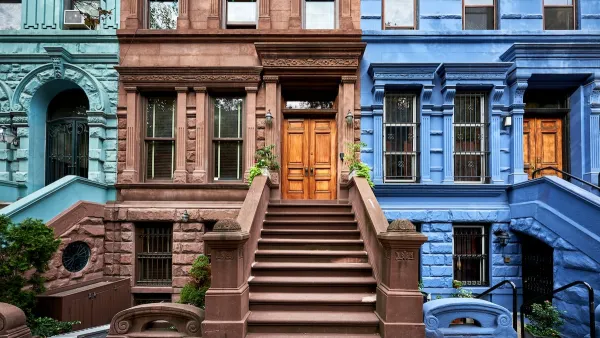What the shoe industry can teach us about the housing crisis.

In an excerpt from their upcoming book, Escaping the Housing Trap: The Strong Towns Response to the Housing Crisis, Charles Marohn and Daniel Herriges claim that “If We Made Shoes Like We Make Housing, People Would Go Barefoot.”
To illustrate their point, the authors write, “Imagine a shoe market that produces only two kinds of shoes: a high-end loafer and an elite-brand tennis shoe.” Companies and governments incentivize the production of just two types of shoe, and “Local permitting restricts the number of shoes that can be made. Rising prices have bloated supply chains, making everything more expensive. The extensive web of public and private capital vested in producing high-end loafers and elite-brand tennis shoes stifles innovation.”
In this world, “Lots of people who want shoes can’t get them. They go barefoot. Those who can buy shoes feel financially squeezed. Price increases are normalized, even expected. Many people are desperate to get any pair of shoes.”
This scenario seems unrealistic—for shoes. “Yet our present housing crisis, which seems normal to us, would be absurd to anyone living a century ago. In the context of millennia of human development, we are the first culture to find ourselves with a chronic shortage of housing.”
For the authors, the answer is clear: “We wiped out the starter rung on the ladder. We need a housing market that produces penny loafers again.”
FULL STORY: If We Made Shoes Like We Make Housing, People Would Go Barefoot

Planetizen Federal Action Tracker
A weekly monitor of how Trump’s orders and actions are impacting planners and planning in America.

Maui's Vacation Rental Debate Turns Ugly
Verbal attacks, misinformation campaigns and fistfights plague a high-stakes debate to convert thousands of vacation rentals into long-term housing.

Restaurant Patios Were a Pandemic Win — Why Were They so Hard to Keep?
Social distancing requirements and changes in travel patterns prompted cities to pilot new uses for street and sidewalk space. Then it got complicated.

In California Battle of Housing vs. Environment, Housing Just Won
A new state law significantly limits the power of CEQA, an environmental review law that served as a powerful tool for blocking new development.

Boulder Eliminates Parking Minimums Citywide
Officials estimate the cost of building a single underground parking space at up to $100,000.

Orange County, Florida Adopts Largest US “Sprawl Repair” Code
The ‘Orange Code’ seeks to rectify decades of sprawl-inducing, car-oriented development.
Urban Design for Planners 1: Software Tools
This six-course series explores essential urban design concepts using open source software and equips planners with the tools they need to participate fully in the urban design process.
Planning for Universal Design
Learn the tools for implementing Universal Design in planning regulations.
Heyer Gruel & Associates PA
JM Goldson LLC
Custer County Colorado
City of Camden Redevelopment Agency
City of Astoria
Transportation Research & Education Center (TREC) at Portland State University
Jefferson Parish Government
Camden Redevelopment Agency
City of Claremont





























